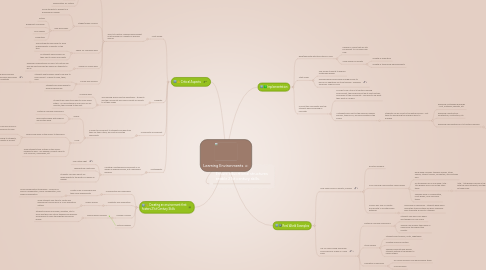
1. Critical Aspects
1.1. Multi-modal
1.1.1. The 21st Century Learning Environment must provide for a variety of learning spaces
1.1.1.1. Garden
1.1.1.1.1. Nutritional Literacy
1.1.1.1.2. Environmental Attitudes
1.1.1.1.3. Teamwork
1.1.1.1.4. Appreciation for Nature
1.1.1.2. Stages/Green Screens
1.1.1.2.1. Allow students to present in a professional manner
1.1.1.2.2. Real world skills
1.1.1.3. Space for Individual work
1.1.1.3.1. Some students may prefer to work independently a majority of the time
1.1.1.3.2. All students need a space of their own to focus and create
1.1.1.4. Space for Group work
1.1.1.4.1. Working collaboratively is a key 21st century skill and we must provide the space for students to do so
1.1.1.5. Formal and Informal
1.1.1.5.1. Students and teachers need to be able to find comfort - a place to relax, think, read
1.1.1.5.2. Students also need space to work professionally
1.2. Flexibility
1.2.1. The learning space must be adjustable - students and the community will need a variety of layouts to fit their needs
1.2.1.1. Movable walls
1.2.1.2. Students will need to be able to move freely within - no more staying in one room for 90 minutes, then moving to the next
1.3. Community Involvement
1.3.1. In order to be relevant to students and help train them for their future, we must involve the community
1.3.1.1. Global
1.3.1.1.1. Distance Learning Classrooms
1.3.1.1.2. Build relationships with schools around the world
1.3.1.2. Local
1.3.1.2.1. Open some areas of the school to the public
1.3.1.2.2. Allow students time outside of the school building to learn - job shadow, present ideas to City Councils, companies, etc.
1.4. Sustainability
1.4.1. Creating a sustainable environment is no longer an expensive perk, but a necessary expense
1.4.1.1. Use natural light
1.4.1.2. Temperature Controlled
1.4.1.3. Students can learn about our responsibility to the Earth in a hands on manner
2. Ensure educational structures enable 21st century skills.
3. Creating an environment that fosters 21st Century Skills
3.1. Collaboration and Teamwork
3.1.1. Create a mix of individual and team work assignments
3.1.1.1. Teach collaboration techniques - allow for in person collaboration, online collaboration, and global collaboration
3.2. Creativity and Imagination
3.2.1. Maker Spaces
3.2.1.1. Allow students free time to create and experience trial and error in a non evaluative setting
3.3. Problem Solving
3.3.1. Inquiry Based Learning
3.3.1.1. Students choose a problem, question, etc to solve and then use critical thinking and problem solving skills to work through the process of inquiry
3.4. Critical Thinking
4. Implementation
4.1. Build/Renovate with the Future in Mind
4.1.1. Develop a Vision that will still be relevant 10-20 years from now.
4.1.2. Allow space for growth
4.1.2.1. Growth in population
4.1.2.2. Growth in technology advancements
4.2. Start Green
4.2.1. This allows students to explore sustainable design
4.2.2. "Building green would save enough money to pay for an additional full time teacher." Greening America's Schools 2006
4.3. Consult the community and the students before building or renovatin
4.3.1. In order to be a true 21st century learning environment, the building must be at least partially accessible to the community - we need to ask what they want in a school
4.3.2. If students are a part of the decision making process, they buy in, be more invested in the school
4.3.2.1. Students can be a part of the entire process - put them to work doing the research prior to building
4.3.2.1.1. Research Sustainable Buildings - cost, materials, benefits, etc.
4.3.2.1.2. Research Construction - architecture, contractors, etc.
4.3.2.1.3. Research Neccessities for 21st century learning
5. Real World Examples
5.1. Olds High School in Alberta, Canada
5.1.1. Rooftop Gardens
5.1.2. Four Learning Communities called Quads
5.1.2.1. Each Quad includes: teachers offices, study spaces, student lockers, computers, and a kitchen area
5.1.2.2. All 9th graders are in one quad; 10th - 12th graders are in one of the other three.
5.1.2.2.1. 10th - 12th graders remain in the same quad, with the same students, and the same teachers all three years.
5.1.2.3. Teachers work in collaborative, multi-grade, cross curricular teams
5.1.3. School day: five 70 minute blocks with 10 minute breaks between
5.1.3.1. One block is Flex period - students have lunch during this time and then are given individual work time with access to a teacher
5.2. Lok Sin Tong Leung Wong Wai Fong Memorial School in Hong Kong
5.2.1. Distance Learning Classrooms
5.2.1.1. Students can learn from peers and teachers all over China
5.2.1.2. Teacher can observe their peers in classrooms throughout the country
5.2.2. Story Garden
5.2.2.1. Students plant flowers, fruits, vegetables
5.2.2.2. Creative space for writing
5.2.2.3. Teachers laminate and display students writing in the garden to inspire others
5.2.3. Innovative Classrooms
5.2.3.1. All rooms include a mini performance stage
5.2.3.2. Colorful desks
5.2.4. Hallways/Other Common Areas
5.2.4.1. Books in the hallway
5.2.4.2. Space Canteen
5.2.4.2.1. Space themed area for lunch and drawing
5.2.4.3. Wall of Appreciation
